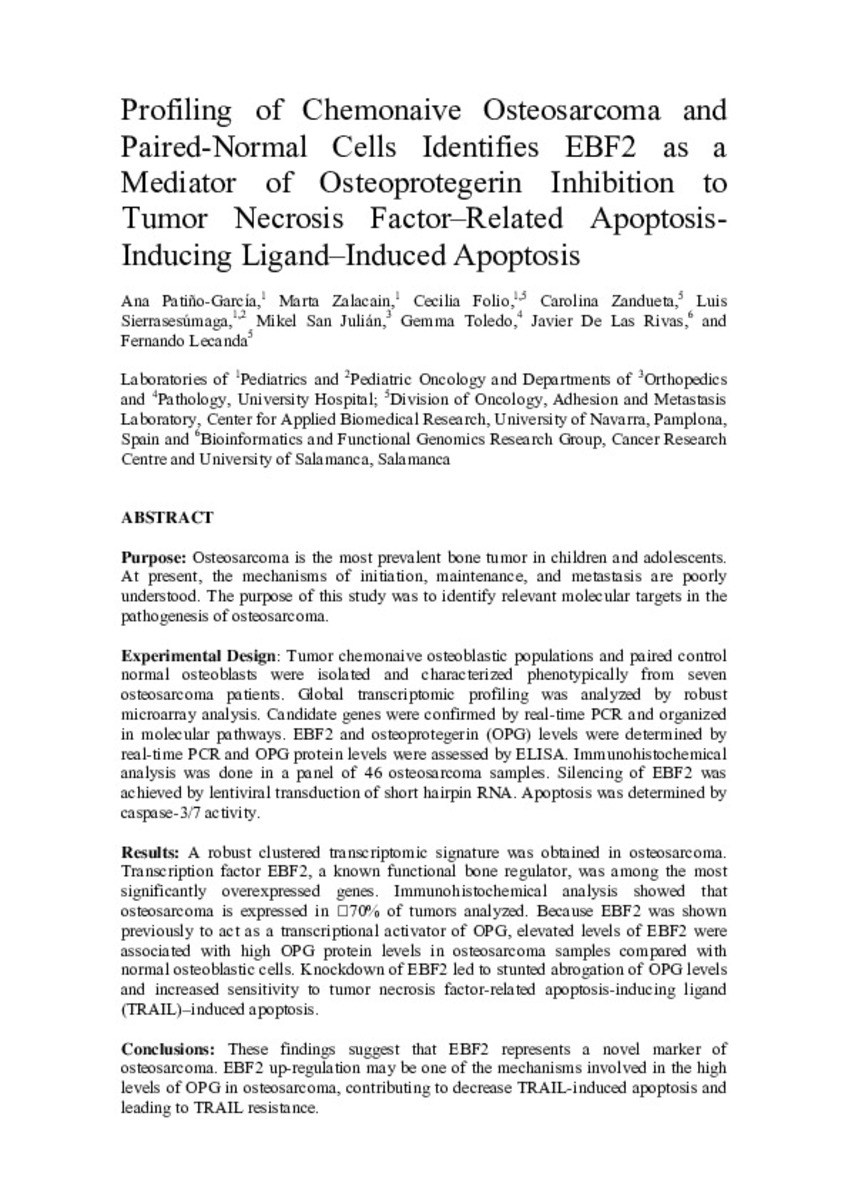Full metadata record
| DC Field | Value | Language |
|---|---|---|
| dc.creator | Patiño-García, A. (Ana) | - |
| dc.creator | Zalacain, M. (Marta) | - |
| dc.creator | Folio, C. (Cecilia) | - |
| dc.creator | Zandueta, C. (Carolina) | - |
| dc.creator | Sierrasesumaga, L. (Luis) | - |
| dc.creator | San-Julian, M. (Mikel) | - |
| dc.creator | Toledo, G. (Gemma) | - |
| dc.creator | Rivas, J. (Javier) de las | - |
| dc.creator | Lecanda, F. (Fernando) | - |
| dc.date.accessioned | 2012-11-20T09:58:34Z | - |
| dc.date.available | 2012-11-20T09:58:34Z | - |
| dc.date.issued | 2009 | - |
| dc.identifier.citation | Patiño-García A, Zalacain M, Folio C, Zandueta C, Sierrasesúmaga L, San Julián M, Toledo G, De Las Rivas J, Lecanda F. Profiling of chemonaive osteosarcoma and paired-normal cells identifies EBF2 as a mediator of osteoprotegerin inhibition to tumor necrosis factor-related apoptosis-inducing ligand-induced apoptosis. Clin Cancer Res. 2009 Aug 15;15(16):5082-91. | es_ES |
| dc.identifier.issn | 1078-0432 | - |
| dc.identifier.uri | https://hdl.handle.net/10171/23725 | - |
| dc.description.abstract | Osteosarcoma is the most prevalent bone tumor in children and adolescents. At present, the mechanisms of initiation, maintenance, and metastasis are poorly understood. The purpose of this study was to identify relevant molecular targets in the pathogenesis of osteosarcoma. EXPERIMENTAL DESIGN: Tumor chemonaive osteoblastic populations and paired control normal osteoblasts were isolated and characterized phenotypically from seven osteosarcoma patients. Global transcriptomic profiling was analyzed by robust microarray analysis. Candidate genes were confirmed by real-time PCR and organized in molecular pathways. EBF2 and osteoprotegerin (OPG) levels were determined by real-time PCR and OPG protein levels were assessed by ELISA. Immunohistochemical analysis was done in a panel of 46 osteosarcoma samples. Silencing of EBF2 was achieved by lentiviral transduction of short hairpin RNA. Apoptosis was determined by caspase-3/7 activity. RESULTS: A robust clustered transcriptomic signature was obtained in osteosarcoma. Transcription factor EBF2, a known functional bone regulator, was among the most significantly overexpressed genes. Immunohistochemical analysis showed that osteosarcoma is expressed in approximately 70% of tumors analyzed. Because EBF2 was shown previously to act as a transcriptional activator of OPG, elevated levels of EBF2 were associated with high OPG protein levels in osteosarcoma samples compared with normal osteoblastic cells. Knockdown of EBF2 led to stunted abrogation of OPG levels and increased sensitivity to tumor necrosis factor-related apoptosis-inducing ligand (TRAIL)-induced apoptosis. CONCLUSIONS: These findings suggest that EBF2 represents a novel marker of osteosarcoma. EBF2 up-regulation may be one of the mechanisms involved in the high levels of OPG in osteosarcoma, contributing to decrease TRAIL-induced apoptosis and leading to TRAIL resistance. | es_ES |
| dc.language.iso | eng | es_ES |
| dc.publisher | American Association for Cancer Research | es_ES |
| dc.rights | info:eu-repo/semantics/openAccess | es_ES |
| dc.subject | Gene Expression Regulation, Neoplastic/drug effects | es_ES |
| dc.subject | Osteoprotegerin/physiology | es_ES |
| dc.subject | Osteosarcoma/genetics/mortality/pathology | es_ES |
| dc.title | Profiling of chemonaive osteosarcoma and paired-normal cells identifies EBF2 as a mediator of osteoprotegerin inhibition to tumor necrosis factor–related apoptosis-inducing ligand–induced apoptosis | es_ES |
| dc.type | info:eu-repo/semantics/article | es_ES |
| dc.relation.publisherversion | http://clincancerres.aacrjournals.org/content/15/16/5082.full.pdf+html | es_ES |
| dc.type.driver | info:eu-repo/semantics/article | es_ES |
Files in This Item:
Statistics and impact
Items in Dadun are protected by copyright, with all rights reserved, unless otherwise indicated.






